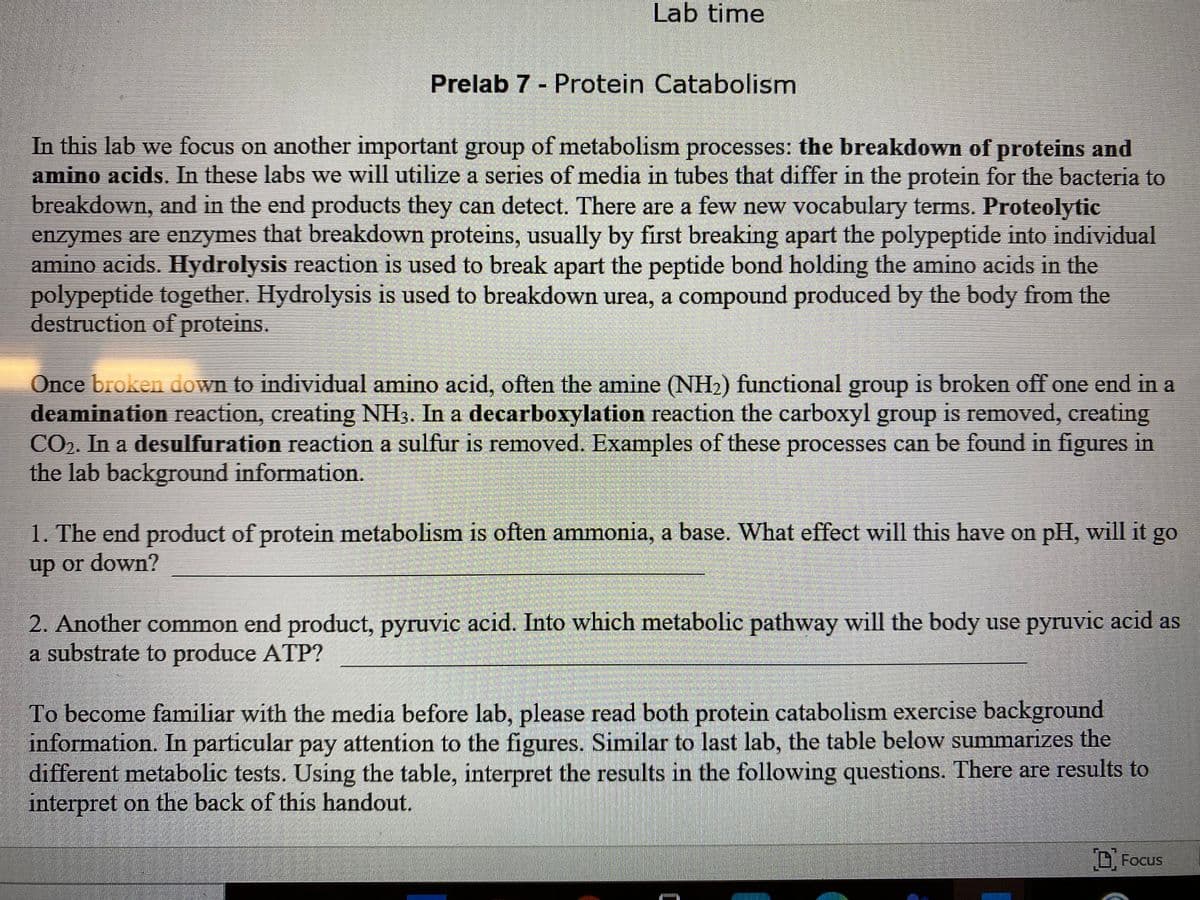The end products of protein metabolism is often ammonia, a base. What effect will this have on pH, will it go up or down? Another common end product, pyruvic acid. Into which metabolic pathway will the body use pyruvic asid as a substrate to produce ATP?
The end products of protein metabolism is often ammonia, a base. What effect will this have on pH, will it go up or down? Another common end product, pyruvic acid. Into which metabolic pathway will the body use pyruvic asid as a substrate to produce ATP?
Human Anatomy & Physiology (11th Edition)
11th Edition
ISBN:9780134580999
Author:Elaine N. Marieb, Katja N. Hoehn
Publisher:Elaine N. Marieb, Katja N. Hoehn
Chapter1: The Human Body: An Orientation
Section: Chapter Questions
Problem 1RQ: The correct sequence of levels forming the structural hierarchy is A. (a) organ, organ system,...
Related questions
Question
The end products of protein
Another common end product, pyruvic acid. Into which metabolic pathway will the body use pyruvic asid as a substrate to produce ATP?

Transcribed Image Text:Lab time
Prelab 7 - Protein Catabolism
In this lab we focus on another important group of metabolism processes: the breakdown of proteins and
amino acids. In these labs we will utilize a series of media in tubes that differ in the protein for the bacteria to
breakdown, and in the end products they can detect. There are a few new vocabulary terms. Proteolytic
enzymes are enzymes that breakdown proteins, usually by first breaking apart the polypeptide into individual
amino acids. Hydrolysis reaction is used to break apart the peptide bond holding the amino acids in the
polypeptide together. Hydrolysis is used to breakdown urea, a compound produced by the body from the
destruction of proteins.
Once broken down to individual amino acid, often the amine (NH2) functional group is broken off one end in a
deamination reaction, creating NH3. In a decarboxylation reaction the carboxyl group is removed, creating
CO2. In a desulfuration reaction a sulfur is removed. Examples of these processes can be found in figures in
the lab background information.
1. The end product of protein metabolism is often ammonia, a base. What effect will this have on pH, will it go
up or down?
2. Another common end product, pyruvic acid. Into which metabolic pathway will the body use pyruvic acid as
a substrate to produce ATP?
To become familiar with the media before lab, please read both protein catabolism exercise background
information. In particular pay attention to the figures. Similar to last lab, the table below summarizes the
different metabolic tests. Using the table, interpret the results in the following questions. There are results to
interpret on the back of this handout.
D, Focus
Expert Solution
This question has been solved!
Explore an expertly crafted, step-by-step solution for a thorough understanding of key concepts.
This is a popular solution!
Trending now
This is a popular solution!
Step by step
Solved in 2 steps

Knowledge Booster
Learn more about
Need a deep-dive on the concept behind this application? Look no further. Learn more about this topic, biology and related others by exploring similar questions and additional content below.Recommended textbooks for you

Human Anatomy & Physiology (11th Edition)
Biology
ISBN:
9780134580999
Author:
Elaine N. Marieb, Katja N. Hoehn
Publisher:
PEARSON

Biology 2e
Biology
ISBN:
9781947172517
Author:
Matthew Douglas, Jung Choi, Mary Ann Clark
Publisher:
OpenStax

Anatomy & Physiology
Biology
ISBN:
9781259398629
Author:
McKinley, Michael P., O'loughlin, Valerie Dean, Bidle, Theresa Stouter
Publisher:
Mcgraw Hill Education,

Human Anatomy & Physiology (11th Edition)
Biology
ISBN:
9780134580999
Author:
Elaine N. Marieb, Katja N. Hoehn
Publisher:
PEARSON

Biology 2e
Biology
ISBN:
9781947172517
Author:
Matthew Douglas, Jung Choi, Mary Ann Clark
Publisher:
OpenStax

Anatomy & Physiology
Biology
ISBN:
9781259398629
Author:
McKinley, Michael P., O'loughlin, Valerie Dean, Bidle, Theresa Stouter
Publisher:
Mcgraw Hill Education,

Molecular Biology of the Cell (Sixth Edition)
Biology
ISBN:
9780815344322
Author:
Bruce Alberts, Alexander D. Johnson, Julian Lewis, David Morgan, Martin Raff, Keith Roberts, Peter Walter
Publisher:
W. W. Norton & Company

Laboratory Manual For Human Anatomy & Physiology
Biology
ISBN:
9781260159363
Author:
Martin, Terry R., Prentice-craver, Cynthia
Publisher:
McGraw-Hill Publishing Co.

Inquiry Into Life (16th Edition)
Biology
ISBN:
9781260231700
Author:
Sylvia S. Mader, Michael Windelspecht
Publisher:
McGraw Hill Education